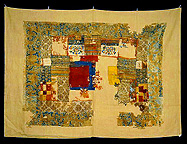
Tang Dynasty, 8th-9th century CE
From Mogao Cave 17, Dunhuang, China
Silk
107 x 149 cm
Acquisition number: # OA MAS 856
Image courtesy of the British Museum (copyright reserved).
This large patchwork of silk was collected by Sir Marc Aurel Stein, who originally suggested that it served as an altar-cloth. However, the pattern of arranged patches along a central vertical axis is consistent with that prescribed for a kasaya (a Buddhist monastic robe), and it has since been identified as such.
Originally, the robes of itinerant monks were continually patched and repaired as a sign of their disregard for worldliness. Laypersons would sometimes donate pieces of cloth to monks as an act of piety, until the many repairs on the garments created a patchwork effect. In later periods, patchwork came to be the norm for monk's robes, created within prescribed patterns. Images of monks in kasaya, such as those seen in Cave 285, can be seen in other locations in the cave complex of Mogao.
In an ironic turn, by the Tang period high-ranking priests and monks had taken to wearing robes patched together from silk brocades donated by wealthy patrons. Experts at the British Museum note that the high quality of the silk "scraps" used create this robe, as well as the presence of the imperial color purple, suggests that the wearer was the priest Hong Bian (active in the mid-ninth century), who is commemorated in the cave where these textiles were found. Hong Bian had been given the right to wear purple by the emperor, and small pieces of purple silk were found inside his statue, as well as stitched into this kasaya.1
(1) See the British Museum web page dedicated to this object.